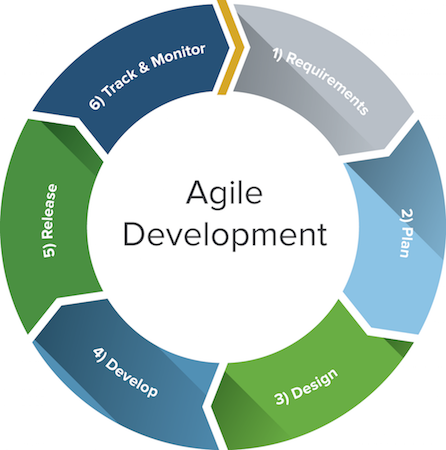From TVs and cars to buying essentials, we are all a part of a vast web of software-driven systems. However, all of these technological advances happened so fast in a decade that it is almost impossible to think about companies that depended on bulky, expensive physical servers for hosting each application. Such inconvenience led to more innovative ways of software development, like having virtual machines for data transition.
As the demand, unpredictability, and audience grew, a holistic software development approach was discovered in the Agile methodology. In recent times, it has led to an upsurge in the demand for Scrum Master Training.
Software Development Progress: Timeline
While there are a lot of people who feel the rapid technological advancement took place because of the better understanding of hardware or the Internet, it might not be entirely accurate. Not long ago, the process of software development was similarly approached to that of manufacturing engines or automobiles. With the painstakingly long stages of planning, design, architecture, formulation, testing, and launch, companies also relied entirely on physical servers for application hosting.
The 1980s was a period of discovering new technologies like Waterfall that can contribute to making the software development process faster in those times, promoting consumerism.
It was then in 2001 that with the increasing numbers of mobile users, developers faced the need to develop browser-based applications at a much faster pace. Such urgency led to a group of developers deciding to transform the existing clunky management system into something meaningful, fast-paced in nature, as well as having better quality standards. This was when the Agile Manifesto got published.
Agile represents a comprehensive method where speed and quality come together in a single step, and later, even plays a crucial role in the automation and rise of DevOps.
What exactly is the Agile Manifesto?
It all began when a group of 17 software developers decided to go on a ski trip to Utah in 2001 and decided to put across four main components and 12 principles to help them through the night. While at first, they did not seem to agree on everything; it did make heads turn on the purpose of the Agile Manifesto. It begins with conceiving the term ‘Agile Manifesto’ as well as identifying the value statements that constitute the foundation of Agile software development.
The four fundamental values of the Agile Manifesto set it apart from all the previous methodologies used for software development like Waterfall, where each subsequent phase of the development process required the completion of its predecessor.
- Individuals and interactions over processes and tools: Agile is built around to give people more important than processes or mechanisms involved, and therefore people can drive faster development processes according to customer needs.
- Working software over comprehensive documentation: Before even the software development process begins, there is a lot of documentation and approvals involved. It slows things down, and therefore Agile believes in simplifying the processes.
- Customer collaboration over contract negotiation: Things get more comfortable when it is done collaboratively rather than fighting it out as a negotiation. Therefore, Agile software development includes making the customer a vital part of the project throughout its lifecycle.
- Responding to changes over following a plan: Agile identifies the need for changes in a project and works in smaller iterations, also known as sprints. Such an approach helps brevity to take control of a project and build value.
After the values, it is the 12 Agile principles that define the course of software development. Here are they:
- Our highest priority is to satisfy the customer through early and continuous delivery of valuable software.
It translates into keeping your customers updated with the progress, deliverables in fixed intervals during the development process.
- Welcome changing requirements, even late in development. Agile processes harness change for the customer’s competitive advantage.
Agile comes with its critical adaptability to last-minute changes without any delay.
- Deliver working software frequently, from a couple of weeks to a couple of months, with a preference to the shorter timescale.
Agile software development paradigm welcomes shorter project timelines with quick turnarounds in delivering quality products.
- Business people and developers must work together daily throughout the project.
It means having effective regular communication with all stakeholders for better yields.
- Build projects around motivated individuals.
Give them the environment and support they need and trust them to get the job done. Agile puts more focus on people working on projects and therefore believes in supporting them in their careers.
- The most efficient and effective method of conveying information to and within a development team is face-to-face conversation.
Nothing beats the clarity of face-to-face live communication with your clients to eliminate miscommunications.
- Working software is the primary measure of progress.
Agile stands for putting importance where it is required, like yielding deliverables rather than time spent.
- Agile processes promote sustainable development. Sponsors, developers, and users should be able to maintain a constant pace indefinitely.
Because of its liberty, a team working in an Agile framework needs to be careful in maintaining a consistent pace through each sprint. It should not come to working overtime or missing out on deadlines for a smooth workflow. To keep up with the technical proficiency involved, team members need to be a constant system of checks and balances.
- Simplicity – the art of maximizing the amount of work not done – is essential.
Anything that does not add value to the yields should be avoided to streamline the workflow.
- The best architectures, requirements, and designs emerge from self-organizing teams.
Agile works best for teams that function as an autonomous, skilled, and motivated system to drive the highest quality results.
- At regular intervals, the team reflects on how to become more productive, and then tunes and adjusts its behavior accordingly.
With continuous self-evaluation, the team should focus entirely on self-growth for better yields.
Importance of Agile Manifesto in Software Development
Agile is more of an umbrella term that represents frameworks like Scrum, Feature Driven Development (FDD), and practices, such as pair programming, test-driven developments, shorter project processes called sprints, etc. When it comes to Agile software development, it derives mostly from Agile Manifesto’s values and principles, while following frameworks and practices. Such methodologies make Agile software development stand apart.
Overall, it can be said that Agile Manifesto and its principles can be considered as foundation stones for building a collaborative and self-sufficient software development method.






















Be First to Comment